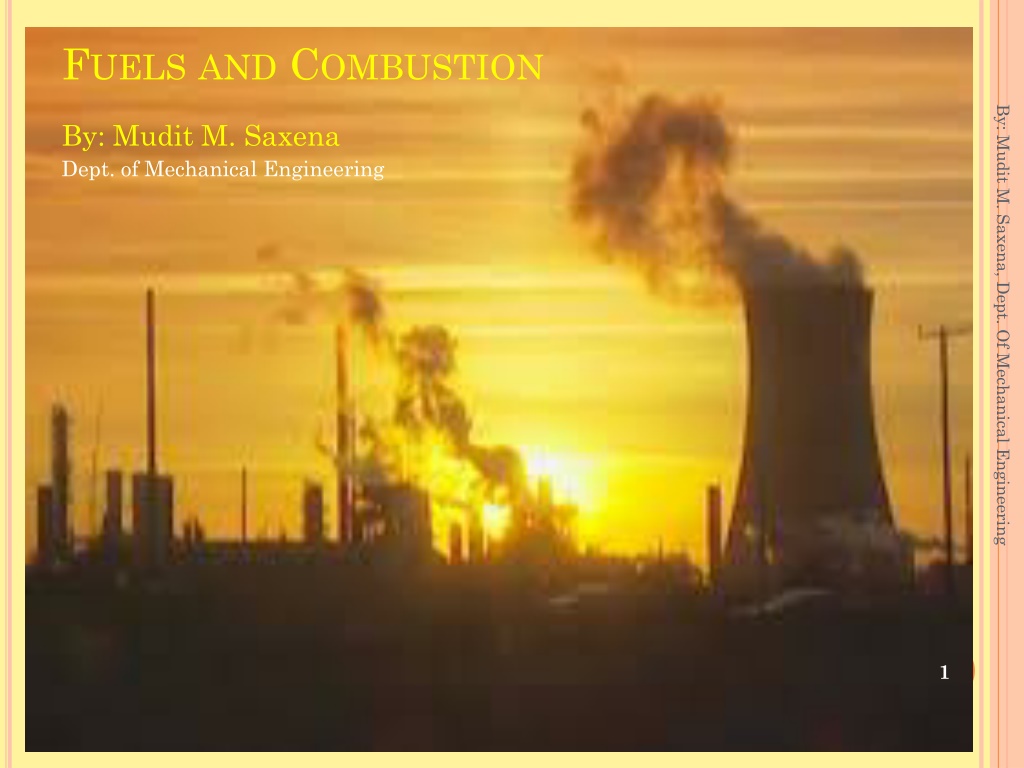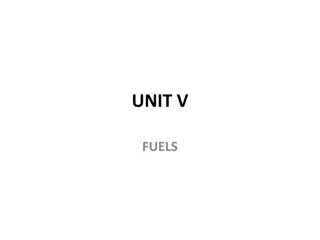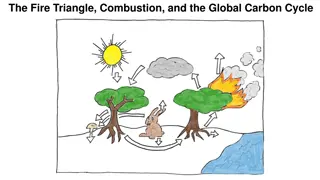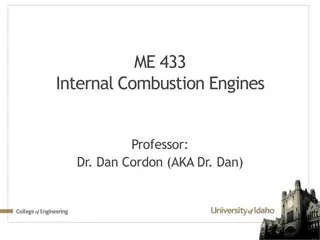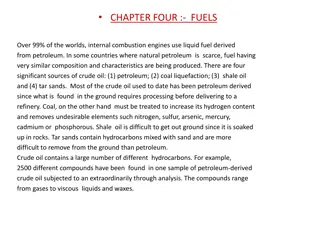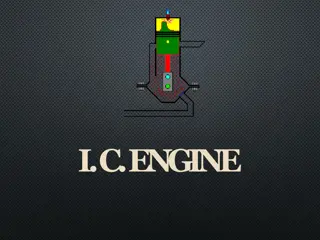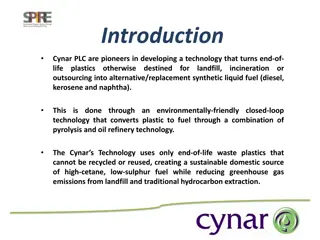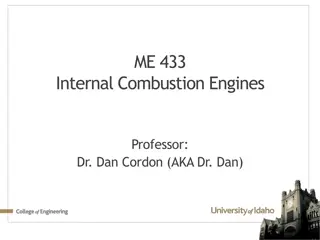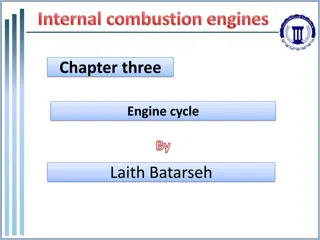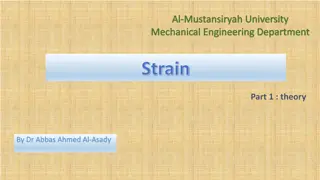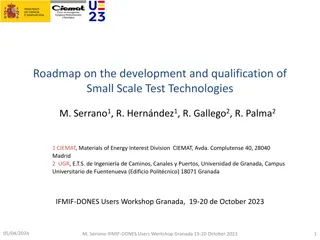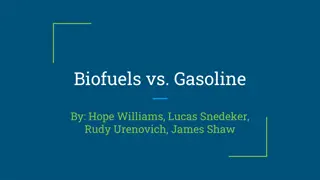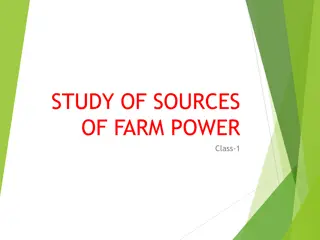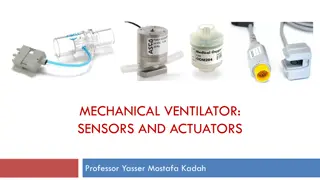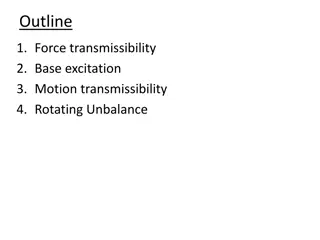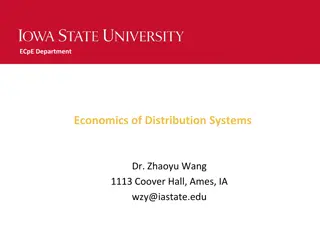Exploring Fuels and Combustion in Mechanical Engineering
This content delves into the intricate world of fuels and combustion, discussing classifications, properties, and origins of various fuels such as solid, liquid, and gaseous. It covers the importance of desirable fuel properties, caloric values, and the different types of natural and artificial fuels. Additionally, it explores the advantages and disadvantages of natural solid fuels like wood, peat, and coal in the context of their calorific values and moisture content.
Download Presentation

Please find below an Image/Link to download the presentation.
The content on the website is provided AS IS for your information and personal use only. It may not be sold, licensed, or shared on other websites without obtaining consent from the author. Download presentation by click this link. If you encounter any issues during the download, it is possible that the publisher has removed the file from their server.
E N D
Presentation Transcript
FUELSAND COMBUSTION By: Mudit M. Saxena, Dept. Of Mechanical Engineering By: Mudit M. Saxena Dept. of Mechanical Engineering 1
SYLLABUS: CH 2, FUELSAND COMBUSTION By: Mudit M. Saxena, Dept. Of Mechanical Engineering Introduction Classification of fuels Solid fuels Liquid Fuels Gaseous Fuels LPG: Liquid Petroleum Gas CNG: Compressed Natural Gas Bio-fuel Hydrogen (H) Gas Combustion Calorific values 2
FUELANDITS DESIRABLE PROPERTIES By: Mudit M. Saxena, Dept. Of Mechanical Engineering Fuel Fuel is is defined carbon carbon and and hydrogen heat heat when when burning defined as hydrogen which burning with as "A "A substance substance made which produced produced a a large with oxygen oxygen. ." " made up large amount up mainly mainly of of amount of of Desirable properties of a fuel: Low ash content High calorific value Small percentage of sulphur Good burning characteristics Easy handling and transportation Easy control on combustion No problem of corrosion and deterioration during storage Economical in use 3
CLASSIFICATIONOFFUEL By: Mudit M. Saxena, Dept. Of Mechanical Engineering (1) According to nature of their existence (i) Solid (ii) Liquid (iii) gaseous (2) According to nature of their origin Natural fuel : They occur in nature. It also known as primary fuel. Artificial fuel: They are prepared fuels. They are also known as secondary fuels. (3) Alternative fuels (1) LPG (4) Bio-fuel : Bio-mass, Biogas, Bio-diesel, Bio-ethanol, Vegetable oil, Syngas (2) CNG (3) Hydrogen gas 4
CLASSIFICATIONOFFUEL By: Mudit M. Saxena, Dept. Of Mechanical Engineering (1) Solid fuel Natural (primary fuel) : - Wood, Peat, Lignite coal Artificial (secondary fuel) : - Coke, Char coal, Briquettes, Pulverized coal. (2) Liquid fuel : Natural : Petroleum Artificial : Gasoline (petrol), Diesel, Kerosene, Fuel oil, Alcohol, Benzol, Shale oil (3)Gaseous fuel: Natural : Natural gas Artificial : Petroleum gas, Producer gas, Coal gas, Blast furnace gas, Sewer gas, Water gas 5
NATURALSOLIDFUEL By: Mudit M. Saxena, Dept. Of Mechanical Engineering Wood: The disadvantages of using wood as a fuel is having large moisture content and low calorific value. Peat: It is first stage in the formation of coal from wood. It is a naturally occurring solid fuel consisting a partly decomposed plant material below ground. It contains huge amount of moisture (90 % water) . All other varieties of coal are derived from peat. It has lowest calorific value. Coal: Coal is fossil fuel laid down from moist vegetable matter and compacted under pressure and temperature within the surface of earth. Coal passes through different stages during its formation from vegetation. 6
DIFFERENTSTAGESOF COAL By: Mudit M. Saxena, Dept. Of Mechanical Engineering Lignite : These are intermediate stages between peat and coal. They have brown colour, high moisture content, low calorific value, had weathering properties. Lignite can be used in generation of electricity in thermal power station. There are large deposits of lignite in India. It burn with large smoky flame. Bituminous coal: It is shining black in appearance. It is easier to ignite. It burn with long yellow and smoky flame. It is main fuel for industrial furnaces, boilers, and thermal power plants. It is also useful to produce artificial solid fuel like coke, liquid fuels like coal, tar or gaseous fuel like producer gas, coal gas etc. Anthracite : It is very hard coal and has shining black luster. It have high calorific value, low volatile matter, high carbon content. It is very suitable fuel for thermal power plant. But it ignites slowly. 7
ARTIFICIALOR PREPAREDSOLIDFUELS By: Mudit M. Saxena, Dept. Of Mechanical Engineering (1) Wood Charcoal : It is produced from wood by Carbonization process. Charcoal is also produced from the incomplete burning of wood with insufficient air. It is extensively used as a fuel in blacksmiths, metal work and for cottage industries. (2) Coke: Coke is produced by reducing volatile matter of bituminous coal. It is hard, brittle and porous. It consist of carbon, mineral matter with 2 % sulphur and small quantities of hydrogen, nitrogen and phosphorus. It is smokeless and clear fuel. Normally it is not use as a fuel, but it is used to produced coal gas, producer gas, blast furnace gas by different processes. 8
ARTIFICIALOR PREPAREDSOLIDFUELS By: Mudit M. Saxena, Dept. Of Mechanical Engineering (3) Briquetted coal: It produced from finely ground coal mixed with suitable binder and pressed together to form blocks or briquettes. The briquettes can be any shape. By this method, it is possible to increase heating value of low quality of coal. (4) Pulverized coal: When coal crushed and produced in powder form is called pulverized coal. Fine powder coal mixed with air rapidly so combustion rate increases. Hence combustion efficiency of boiler with pulverized coal is very high. 9
LIQUID FUELS By: Mudit M. Saxena, Dept. Of Mechanical Engineering The liquid fuels are hydrocarbons and general chemical formula is CnHm . It can be classified as Natural fuel - Petroleum (crude oil) Artificial prepared fuel - Tar, Alcohols 10
NATURAL LIQUIDFUELS By: Mudit M. Saxena, Dept. Of Mechanical Engineering Petroleum (Crude Oil) : Petroleum fuels are commonly found under the earth's surface by drilling wells in the earth's crust. It is not used in its raw state. It is required to remove dirt, water and other impurities associated with it. 11
ARTIFICIALOR PREPARED LIQUIDFUELS By: Mudit M. Saxena, Dept. Of Mechanical Engineering The following fuel oils of different grade are products of fractional distillation of petroleum. Petrol : It is the lightest and most volatile fuel. It is mainly used for light petrol engine. Petrol comes out at 650 to 220 C by distillation of crude oil. It is also known as gasoline. Kerosene : Kerosene distills at 2200 to 345 C. It is heavier and less volatile than petrol. It is used for heating and lighting purposes. It is also known as paraffin oil. Diesel oil : It is distilled after petrol and kerosene. These fuel are used in diesel engines. They are distilled at temperature from 345 to 470 C. But require more special and light fuel oil. 12
ARTIFICIALOR PREPARED LIQUID FUELS By: Mudit M. Saxena, Dept. Of Mechanical Engineering LDO: Light diesel oil: Required by modern high speed engine Tar: It is an important by product obtained from the manufacture of coal gas. When it redistilled, important fuel like benzene is produced. Alcohol : It is formed by fermentation of vegetable matter. It is an artificial liquid fuel. The cost of alcohol is higher than petrol. The energy content of alcohol is lower than petrol. 13
THEADVANTAGESANDDISADVANTAGESOF LIQUIDFUELCOMPAREDTOSOLIDFUELS Advantages : It is easy to store and required less space for storage. Higher calorific value. Easy to control of combustion. Easy handling and transportation. Cleanliness, No ash problem Ease of ignition and shutting off the operation Changes in load in a power plant can easily be met. By: Mudit M. Saxena, Dept. Of Mechanical Engineering Disadvantages : Cost of fuel is higher than other fuel. Greater risk of fire. Special container required for storage and transport. 14
By: Mudit M. Saxena, Dept. Of Mechanical Engineering GASEOUS FUELS (1) Natural gas and (2) The prepared gases like coal gas, coke oven gas, producer gas, water gas, blast furnace gas, LPG, CNG. 15
NATURAL GASEOUS FUELS By: Mudit M. Saxena, Dept. Of Mechanical Engineering (1) Natural gas : It consist of mainly methane and with small quantities of ethane, propane and hydrocarbons. It is found in upper part of petroleum field, under the earth's surface. It is used for domestic and industrial heating. The calorific value of the natural gas is 37000 to 46000 kJ/m' at standard condition. 16
ARTIFICIALOR PREPARED GASEOUS FUELS By: Mudit M. Saxena, Dept. Of Mechanical Engineering Coal gas : It consist of mainly of hydrogen, carbon monoxide and hydrocarbons. It is produced by carbonization of coal. It use in boilers and sometimes used for commercial purposes. Coke-oven gas : It is produced during production of coke by heating the bituminous coal at 6000 C to 10000 C. The characteristic and composition of coke oven gas is similar to coal gas. It is used for industrial heating and power generation purpose. 17
ARTIFICIALOR PREPARED GASEOUS FUELS By: Mudit M. Saxena, Dept. Of Mechanical Engineering Producer gas : This gas is produced by partial combustion of solid fuels (gasification), by incomplete combustion of coal in presence of limited amount of air supplied. This gas mainly mixture of carbon monoxide, hydrogen and little amount of other elements. It used in steel industry for firing open hearth furnace. Water gas : This is produced by the blowing steam on white hot coke or coal. It is mainly mixture of carbon monoxide and hydrogen. Steam (water vapour) being required for its manufacture, so this gas is known as water gas. It burn with a blue flame. Therefore it is also known as blue gas. 18
ARTIFICIALOR PREPARED GASEOUS FUELS By: Mudit M. Saxena, Dept. Of Mechanical Engineering Blast furnace gas : It is by-product of smelting operation in which air is forced through layers of iron ore, lime stone and coke in a blast furnace. It is mixture of carbon dioxide, carbon monoxide, hydrogen, nitrogen etc. It is used in gas engines. The heating valve of this gas is very low. 19
ADVANTAGESANDDISADVANTAGESOF GASEOUSFUELS Advantages of gaseous fuels: Less air is required for complete combustion. Good fuel economy and more efficiency of furnace operation. Better control of combustion.. Burns with very less smoke and no ash. Can be distributed with the help of pipe lines. Economical in consumption. High calorific Values. By: Mudit M. Saxena, Dept. Of Mechanical Engineering Disadvantages of gaseous fuels : They are inflammable. Gas is more difficult to transport by pipe line compared to liquid fuel. Liquefied gases required either high pressure or low temperature insulated expensive tanks. 20
ADVANTAGESOFGASEOUSFUELSOVER SOLIDANDLIQUIDFUELS By: Mudit M. Saxena, Dept. Of Mechanical Engineering The gases can be produced easily at one point and has the ease of distribution with the help of pipes. Combustion of these fuels can be controlled to the desired level. Economy in consumption Very less smoke and no ash. System remains neat and clean. Low grade fuels can be used for gasification. 21
LPG (LIQUEFIED PETROLEUM GAS) By: Mudit M. Saxena, Dept. Of Mechanical Engineering LPG is a colorless petroleum gas. It is natural derivative of both natural gas and crude oil. The main component gases of LPG are Propane and Butane or a combination of these two constituents. The gas is liquefied by moderate compression at normal temperatures and is stored in tanks and cylinders. The liquefaction is necessary to provide a reduction in volume and produce acceptable energy densities. LPG is a fuel for cooking. Also, LPG is a fuel which can run cars, buses and lorries. LPG can be used in engines of vehicles after conversion of vehicle for LPG or modification in engine. 22
LPG (LIQUEFIED PETROLEUM GAS) By: Mudit M. Saxena, Dept. Of Mechanical Engineering Advantages of using LPG in automobiles Cheaper than petrol. Running cost is low. As a rough data, the cost of LPG is 50 % compared to petrol, Pollution produced by LPG vehicles is 15% lower than petrol vehicles. It produces less amount of carbon monoxide and hydrocarbons compared to petrol vehicles. It deposits less sulphur in the engine. Disadvantages of using LPG over Petrol and diesel, in automobiles Cost of converting engine from Petrol to LPG is high. It needs special care during refueling operations against leakage. Refueling facilities is limited. 23
CNG (COMPRESSEDNATURAL GAS) By: Mudit M. Saxena, Dept. Of Mechanical Engineering CNG is made by compressing methane which is extracted from natural gas and stored at high pressure about 200 bar. The main components gas of CNG is methane. In addition of methane, it also contains small percentage of ethane, propane, butane and pentane. Due to high octane number CNG is an excellent fuel for petrol engine and more efficient. 24
ADVANTAGESOFUSING CNG By: Mudit M. Saxena, Dept. Of Mechanical Engineering Advantages of using CNG over Petrol and diesel, in automobiles CNG fuel is burned at a higher temperature therefore reducing engine knock. Pollution produced by CNG vehicles is less than petrol vehicles. CNG gives longer service life and lower maintenance costs. Disadvantages of using CNG over Petrol and diesel, in automobiles Cost of converting engine from Petrol to CNG is high. It need special care during refueling operations against leakage. Storage tank in vehicle have to be robust and heavy because of the high pressure requirement. It is expensive because the cost of converting cars to CNG is high. Refueling facilities is limited. 25
BIO-FUEL Bio fuel is a gas or liquid combustible substance made form biomass. Biomass is a material derived from recently living organisms. It includes plants, animals and their by- products. For example drop residues, manure, wood grass, domestic refuse, agricultural and forest crops, animal and human waste and garden waste are all sources ofbiomass. It is a renewable energy source based on the carbon cycle, unlike other natural resources such as petroleum, coal and nuclear fuels. The bio-mass is converted into useful fuels by following bio-conversion routes The bio-chemical conversion as Anaerobic digestion and fermentation biogas. Thermo chemical conversion as gasification and liquefaction-ethanol, methanol. Direct combustion such as wood waste and bagasse. By: Mudit M. Saxena, Dept. Of Mechanical Engineering 26
ADVANTAGESAND DISADVANTAGESOF BIO-FUEL By: Mudit M. Saxena, Dept. Of Mechanical Engineering Advantages of using bio-fuel in vehicles. Reduce pollution Reduce the use of fossil fuel (petroleum). Increase opportunities for rural peoples. Increase national energy security Limitation of bio-fuels Bio-fuel production process is very slow and traditional. It must be redesigned and replaced rapidly. To reduce the price of bio-fuel, bio-fuel production has to be subsidized by government. 27
SOMEOFTHEBIO-FUELS By: Mudit M. Saxena, Dept. Of Mechanical Engineering Bio-diesel : It is made from vegetable oil. A fat or oil is reacted with an alcohol, like methanol, together with a catalyst to produce glycerin and methyl esters (the chemical name of bio-diesel). The process results in bio-diesel and by product glycerin. Biodiesel can be mixed with diesel with any proportion. For example, 20 % of fuel is bio-diesel and 80% is regular diesel, commercially, it is known as B20 bio-diesel. Diesel engine, can run on pure bio-diesel (B 100) with little modification. Bio-diesel produces lower pollution compared to pure diesel. 28
SOMEOFTHEBIO-FUELS By: Mudit M. Saxena, Dept. Of Mechanical Engineering Bio-ethanol : Bio-ethanol is produced from crops such as sugar beet, sugar cane, corn etc. Ethanol can be produced from biomass by hydrolysis and sugar fermentation processes. Bio-ethanol can be mixed with petrol at any proportion. The 85% Bio-ethanol mixed with 15% petrol, commercially, it is known as E85 bio-ethanol. Petrol engines can run on a 5% bio-ethanol with petrol (E5) without any modification. Above 10% bio-ethanol, engine has to modified. 29
SOMEOFTHEBIO-FUELS Vegetableoil : Vegetable oil can be used for either food or fuel. It can be used in many older diesel engines, but only in warm climates. For example, Jatropha, coconut etc. In most cases, vegetable oil is used to manufacture bio-diesel. By: Mudit M. Saxena, Dept. Of Mechanical Engineering Bio-gas : Bio-gas is produced by the process of anaerobic digestion of organic materials like animal waste, agricultural waste and municipal waste. The solid by product can be used as solid bio-fuel or fertilizer. Syngas : It is produced by the combined process of pyrolysis, combustion and gasification. 30
HYDROGEN (H2) GAS H2 produces large energy in combustion compared to petrol and diesel. It reduces the environmental pollution. The major problem of using H2 as fuel is due to high explosive nature in the combustion. Also speed of flame development is very high. H2 can be used as fuel for power generation in fuel cells. The recent development is going on to use of H2 as fuel in automobiles. By: Mudit M. Saxena, Dept. Of Mechanical Engineering Combustion The combustion of fuel, is the process of chemical combination of carbon, hydrogen and sulphur with oxygen which comes from air. Ignition temperature The temperature at which the fuel is burnt continuously without supply of heat . 31 Fuel + Air Heat + Product of combustion
CALORIFICVALUE By: Mudit M. Saxena, Dept. Of Mechanical Engineering Calorific value The amount of energy produced by the complete combustion of unit mass or volume of a fuel is called calorific value. The unit of calorific value is as (1) kJ/kg for solid and liquid fuels (2) kg/m3 for gaseous fuels. Higher or Gross calorific value (H.C.V.) : When heat is taken away by the hot flue gases and the steam is taken into consideration i.e. if the heat is recovered from the flue gases and steam is condensed back to water at room temperature usually taken as 15 C, then the total heat produced per kg is known as Gross or Higher Calorific Value (HCV) of the Fuel. Higher or gross calorific value measured by constant volume calorimeter in which the steam is condensed and heat of vapour is recovered. 32
CALORIFICVALUE By: Mudit M. Saxena, Dept. Of Mechanical Engineering Lower or net calorific value (L.C.V.) : The amount of heat produced by the combustion of unit quantity of fuel without the condensation of steam formed is called the lower calorific value. If higher calorific value is known then the lower calorific value may be obtained by subtracting the amount of heat contained steam from H.C.V. It can be expressed in following way LCV = HCV - 2465 mw (kJ/kg) where mw is the mass of water vapour (Steam) produced by combustion of 1 kg of fuel and 2465 kJ/kg is the latent heat of water at saturation temperature 15 C. 33
ASSIGNMENT - 2 By: Mudit M. Saxena, Dept. Of Mechanical Engineering Q 1. Q 2. How the fuels can be classified ? Q 3. What are the advantages and disadvantages of liquid fuel compared to solid fuels. Q 4. What are advantages of gaseous fuels over solid and liquid fuels. Q 5. What are the problems in using fuel. Q 6. Write a short note on CNG. Q 7. What are the advantages and disadvantages of fuels. Q 8. Write a short note on LPG. Q 9. Write a note on Bio-fuels. Name some of the bio- fuels. Q 10. What is calorific value ? What is its unit ?Explain Higher calorific value and Lower calorific value. Define fuel. What are its desirable properties. Hydrogen as a bio- 34
